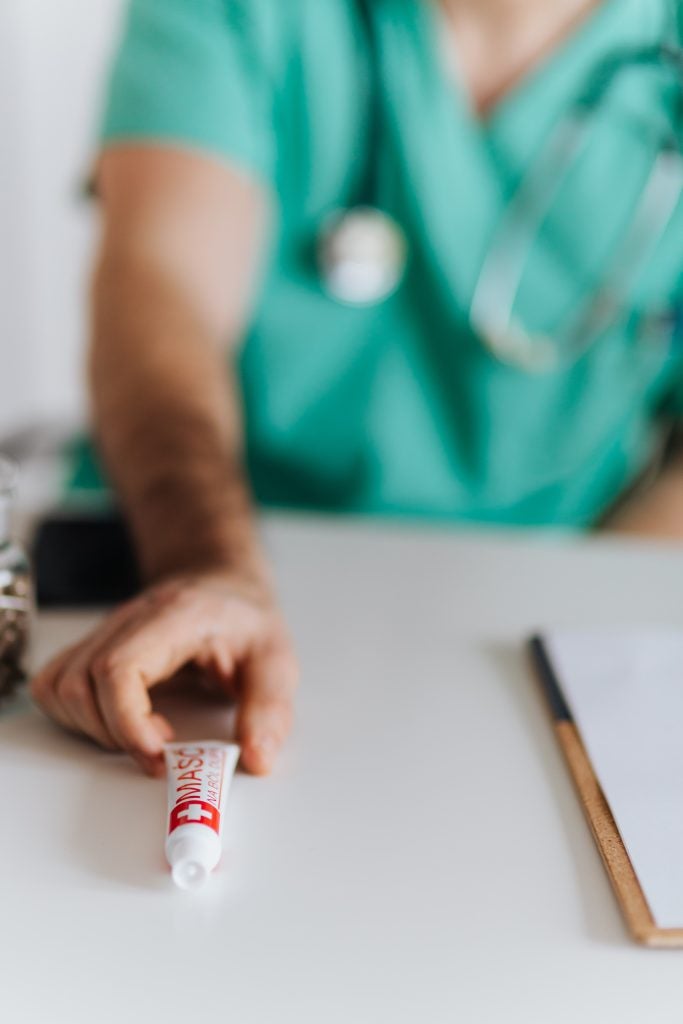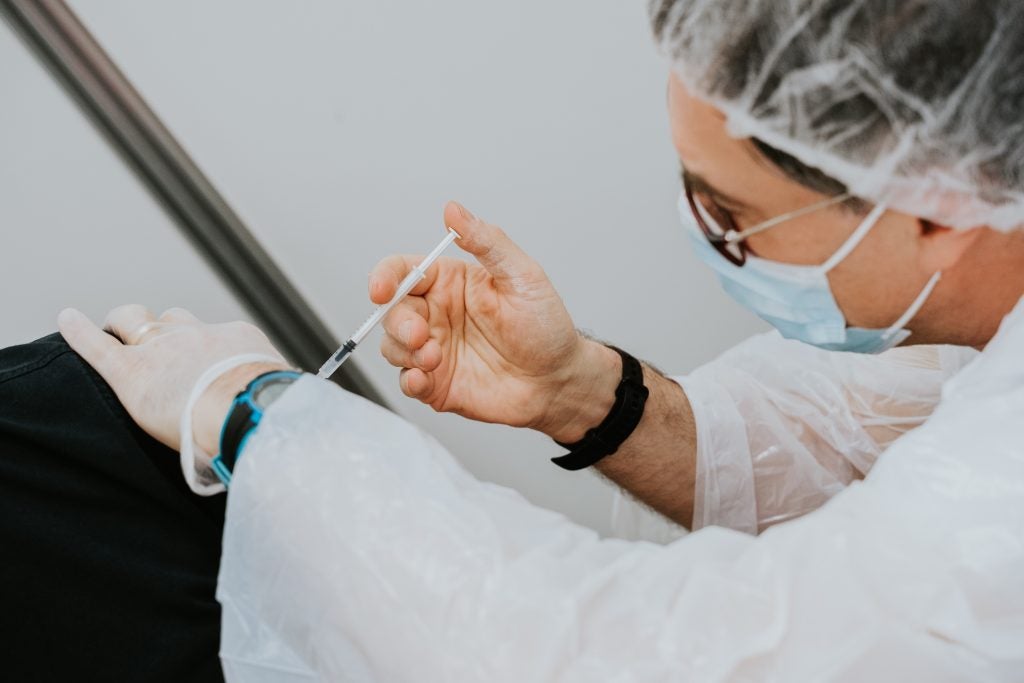Human Papillomavirus (HPV) is a virus with over 150 strains, also called HPV “types.” More than 40 types of HPV are transmitted sexually, and can infect the genitals as well as the mouth and throat. HPV is currently the most common sexually transmitted infection (STI) in the United States. According to the Centers for Disease Control and Prevention (CDC), 43 million people were infected with HPV in 2018.1 Most people with HIV do not even know that they have contracted it and will unknowingly transmit it to their partners during sexual activity.1
Table of Contents
HPV Types
There are over 150 types of the HPV virus, which fall into low-risk and high-risk categories. Low-risk types of HPV usually do not result in disease, but can manifest as warts around the genitals, anus, mouth, or throat.2 The high-risk types are more likely to lead to more severe diseases, such as cancer. Specifically, types 16, 18, 31, 33, 35, 39, 45, 51, 52, 56, 59, 59, 66, and 68 are the 14 high-risk types of HPV that can lead to cancer.2

Transmission
HPV is most commonly transmitted during vaginal, anal, and oral sex but can also occur via skin-to-skin contact with an infected person. It is not common for kissing to lead to transmission, but oral HPV infections can occur after performing oral sex on an infected individual. Other types of sexual skin-to-skin contact, such as foreplay and manual stimulation, and sharing sex toys with an infected person can also result in the spread of HPV.2 Although rare, it is possible for mothers to pass HPV to infants during childbirth. Studies have shown that the possibility of transmission from mother to child increases with the HPV DNA load present in the mother.3
The virus can also be transmitted even if the infected person has no symptoms. Anyone who is sexually active is at risk of contracting HPV, regardless of the individual’s number of sexual partners.1 In fact, the most common time for people to become initially infected with HPV is right after they first become sexually active.2
Symptoms
In many cases, HPV does not cause any noticeable symptoms, and it may take months or even years after the initial infection for symptoms to appear. Most often the body’s immune system is able to fight off the infection on its own, and the virus goes away within roughly two years without ever causing any problems for the infected individual. Therefore, many people who are currently infected with one or more strains of the virus have no idea that they have contracted it. When they do occur, symptoms of HPV manifest in the form of cell overgrowth; an infected person can develop benign warts or even cancer.1 HPV does not cause infertility, though some studies have shown a decrease in sperm motility in HPV-positive people with penises.4
Genital Warts
HPV causes almost all warts on the human body, but different strains of HPV cause warts in different areas. Genital and anal warts are most frequently caused by HPV types 6 and 11.5 Most warts are, in fact, types of benign tumors that develop when the HPV enters a cell and causes cell division. Anal and genital warts generally do not cause any health problems but are highly infectious.
Warts may vary in appearance from large cauliflower-like growths to small pink bumps that can be difficult to see. They may be raised or flat and may grow and spread rapidly.6 Although they can be itchy, they are not typically painful. For people with vulvas, genital warts can develop on the inner and outer labia, the lower area of the vagina, on the cervix, and around the anus. For people with penises, warts may appear on the shaft or on the tip of the penis, on the scrotum, and around the anus.
Genital warts can also develop in the mouth or the throat of a person who has performed oral sex on an infected person. The CDC reports that about 360,000 people infected with HPV experience warts as a symptom annually. Genital warts can be treated or removed by a doctor. If left untreated, the warts may grow, remain the same, or go away with time.1
Cancer
Some types of HPV can cause cell overgrowth that leads to cancer of the vulva, vagina, anus, penis, throat or tonsils.2 Annually, 19,400 people with vulvas and 12,100 people with penises will be diagnosed with cancer caused by HPV.2 There are at least 13 known strains of cancer-causing HPV, all of which are different from the strains that cause warts.2 The most common HPV-related cancer is cervical cancer, which is a major concern for people with vulvas, as there are about 12,000 new cases per year.1 HPV types 16 and 18 are the most common types that cause cancer of the genitals and are responsible for more than 95% of all cervical cancer cases.7 Strains like HPV 16 and 18 first cause precancerous lesions in the genital region, which can develop into cancer later in life.
Once precancerous lesions are present, it can take many years for cancer to develop, and in some cases, it may not develop at all. Symptoms of cancer include pelvic pain, vaginal bleeding, or swelling of the glands.2 These symptoms do not usually occur until cancer has progressed into advanced stages.2 There is no way to know with certainty if cancer will develop from a cancer-causing strain of HPV in a given patient, but it is known that people with weak or compromised immune systems (such as those with HIV/AIDS) are more likely to develop cancer than those with fully healthy immune systems.7
Treatment
Genital Warts
Because the immune system typically fights off most types of HPV, genital warts may go away on their own, without any medical intervention.6 It is up to individuals’ discretion whether or not to see a doctor regarding them.
Unfortunately, there is currently no treatment to eliminate HPV. Doctors can, however, remove warts by freezing them off with liquid nitrogen (cryotherapy), burning them with an electric current, removing them with lasers, or simply cutting them off.6 In some cases, prescriptions for genital wart creams are available for at-home treatment. A patient should revisit their doctor if warts return after treatment. While removing the warts does not get rid of the actual virus, it does lower the risk of transmitting HPV to other people.6

Precancerous HPV
Because of the asymptomatic nature of precancerous HPV, it is critical for people with vulvas to get routine Pap smears to test for cervical abnormalities. This ensures that any precancerous HPV is detected and treated before it develops into cancer.2
Pap smears are generally administered every three years, beginning after people with vulvas have sex for the first time or reach 21 years of age, whichever comes first. To administer a pap smear, a gynecologist obtains a small sample of cells and mucus from the cervix and examines it under a microscope to check for abnormalities. There are two main types of abnormalities: low-grade lesions and high-grade lesions. Lesions are simply areas of abnormal tissue. Low-grade lesions are fairly common and usually resolve naturally within two years; thus, if a pap smear detects a low-grade lesion, a gynecologist will most often recommend a follow-up appointment in six months to monitor the lesion. High-grade lesions have a relatively high chance of developing into cervical cancer and must be treated aggressively. The three most common types of treatment are freezing, laser burning, or electric excision of the abnormal cervical tissue. If advanced cervical cancer develops, it is treated either by chemotherapy or hysterectomy (the removal of the uterus and cervix).2

Cancer-causing HPV does not usually result in pre-cancerous symptoms in people with penises. Thus, they are often carriers and unknowingly infect their sexual partners. Fortunately, most individuals are able to eliminate the virus naturally without experiencing any issues. There are currently no FDA-approved screening tests for any cancer-causing HPV besides cervical cancer, so it can be difficult to know if a person with a penis has contracted an asymptomatic strain of cancer-causing HPV until it manifests into late-stage cancer.2
Prevention
Vaccines
There are currently three FDA-approved HPV vaccines available in the United States. All of the vaccines protect against types 16 and 18, which are the most likely to cause cancer. The vaccine that is most commonly administered to both people with penises and people with vulvas is called Gardasil 9 and protects against types 16 and 18, types 6 and 11 (which cause genital warts), and 5 other cancer-causing types.8 The vaccine is typically given in a series. For individuals between the ages of 9 and 14, there is a series of 2 shots. For individuals 15 to 45 years of age, there is a series of 3 shots.
The HPV vaccines are most effective when they are administered before a patient has been exposed to the virus. For this reason, the CDC recommends that all individuals receive the vaccine before having any sexual encounters, which is why many people do so when they are 11 or 12 years old.1 However, individuals who have already begun engaging in sexual behavior are also encouraged to get the vaccine, even though the chance that they have already been exposed to one or more of the types of HPV the vaccine protects against is significantly higher.1

HPV vaccines have been shown to be extremely effective at protecting against up to 90% of HPV types for several years (roughly six to eleven).8 Side effects are typically uncommon and mild, and include pain and swelling at the injection site, headache, nausea, dizziness, and fainting.9 Although these vaccines are designed to protect against the most severe types of HPV, they do not protect against all types, so it is still recommended to be tested for the virus often and take other preventative measures, such as using barrier methods of contraception .1
One common misconception about the HPV vaccine is that administering it to young individuals will encourage them to engage in sexual behavior early on. However, many studies have proven that this is not the case.8 Receiving the vaccine as early as possible merely ensures that the vaccine will be most effective.
Vaccination is an effective means of preventing against contraction and transmission of HPV. Additionally, because there are no current screening methods for people with penises, it is particularly important for them to get vaccinated to prevent the contraction of a cancer-causing HPV type and to prevent transmission to others.
Cancer Screenings
For people with vulvas who are sexually active, routine cancer screenings in the form of a pap smear and pelvic exam are recommended between the ages of 21 and 65 years old.1 Routine pap smears can detect early signs of potential cancer to treat HPV before it leads to cancer. To read more about what happens during a pap smear, click here.
Safe Sex Practices
In addition to getting vaccinated and attending routine check-ups, having safe sex is an important strategy for reducing the risk of contracting HPV. Condoms and dental dams are effective at preventing the transmission of most sexually transmitted infections (STIs). Condoms and dental dams should be used correctly for all acts of sex, including oral sex. Unfortunately, HPV can be transmitted via contact with genital areas that are not covered by condoms, so it is possible to contract the virus even when using protection. Still, using protection greatly decreases the chances of contracting HPV.

If you are in a monogamous sexual relationship (i.e., only having sex with one person for a given period of time), it can be easier to communicate with your partner about getting tested for HPV and there is a higher likelihood of being sure of their HPV status. However, regardless of how many sexual partners you have, it is crucial that you talk with them about getting tested, and that you do not engage in unprotected sex with anyone you do not trust to have been tested for HPV and other STIs since their last sexual encounter.
Cleaning your sex toys thoroughly after every use is another safe sex practice that can help prevent the spread of HPV and other STIs. For a guide on sex toys and how to maintain them, click here.
If you believe you have contracted HPV or any other STI, it is best not to engage in any kind of sexual contact with others until you have received a negative test result. If you or your partner has been diagnosed with HPV, keep in mind that this does not mean that either of you has done anything wrong, or that your sexual relationship will be affected. You may be advised to see a doctor periodically until the infection clears up to make sure that no complications arise.
Concluding Remarks
In conclusion, Human Papillomavirus (HPV) is a very common virus. After all, it is possible that any given sexually active individual will experience an HPV infection at least once in their lifetime.5 Most of the time, HPV is nothing to worry about and the human body can fight it off on its own. However, when the virus leads to warts or cancer, the effects can be uncomfortable and even life-threatening. Luckily, there are steps that can be taken to reduce the risk of spreading and contracting HPV. Taking preventative measures and practicing healthy communication with all sexual partners about getting tested as well as keeping up a healthy lifestyle can help to ensure that HPV does not impact your health in a negative way.
References
- Centers for Disease Control and Prevention. (2022, April 12). Std Facts – Human papillomavirus (HPV). Centers for Disease Control and Prevention.
- HPV and cancer. National Cancer Institute. (n.d.). Retrieved May 9, 2022.
- Petca, A., Borislavschi, A., Zvanca, M. E., Petca, R. C., Sandru, F., & Dumitrascu, M. C. (2020). Non-sexual HPV transmission and role of vaccination for a better future (Review). Experimental andtherapeutic medicine, 20(6), 186.
- Jeršovienė, V., Gudlevičienė, Ž., Rimienė, J., & Butkauskas, D. (2019). Human Papillomavirus and Infertility. Medicina (Kaunas, Lithuania), 55(7), 377.
- Parenthood, P. (n.d.). What is HPV & how do you get it? Planned Parenthood. Retrieved May 9, 2022.
- Parenthood, P. (n.d.). What are the symptoms & signs of genital warts? Planned Parenthood. Retrieved May 9, 2022.
- World Health Organization. (n.d.). Cervical cancer. World Health Organization. Retrieved May 9, 2022
- Parenthood, P. (n.d.). HPV vaccine: What is the HPV vaccination. Planned Parenthood. Retrieved May 9, 2022.
- Centers for Disease Control and Prevention. (2021, July 23). HPV vaccine. Centers for Disease Control and Prevention. Retrieved May 9, 2022.
Last updated: 24 May 2022
